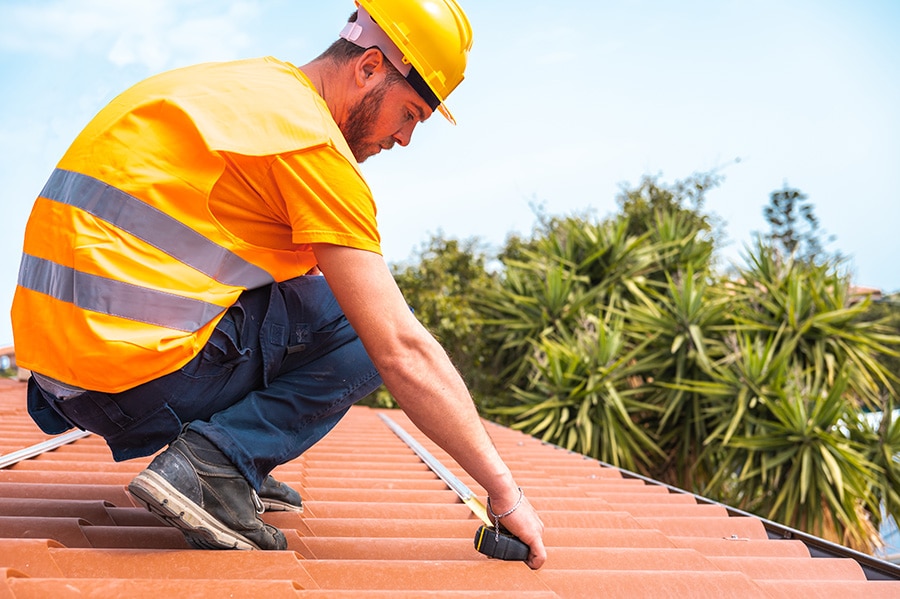As a homeowner, your roof’s pitch is an important number that you should not only know, but also fully understand. The roof pitch is a key number that determines your roofing material, gutters, effectiveness in inclement weather, and many more roofing choices. If you are planning on a roofing project in the near future, you will want to figure out the pitch first.
Keep reading to learn what the roof pitch is, how to determine what the pitch of your roof is, and a few other tips to help you understand it. Craven Construction has over 20 years experience in the roofing industry and utilizes the roof pitch for all roofing repairs, maintenance projects, and new roof installations.
What is a roof pitch?
The pitch refers to the steepness of the roof and is also referenced as the slope, incline or angle. Roofers typically use the term “pitch”. To determine a roof’s pitch, you factor how many inches of the roof rise for every 12 inches of depth. For example, a roof that rises 4 inches for every 12 inches of depth would have a pitch of 4/12.
How do you measure the pitch?
Describing the roof pitch is easy on paper, or a screen, but to actually measure the pitch is a bit more difficult. If you cannot do so safely, please consult a roofing professional before attempting to measure the pitch yourself. Be sure you have a sturdy ladder and the ability to climb on your roof before you embark on this project.
Using a tape measure to measure the span of the roof from one side to the other – a straight line across to give you the depth. Once you have this number, measure the rise or the height from the edge to the roof’s peak. To put this all into context, if your first measurement, the depth, is 30 feet and the rise is 10 feet, then your roof pitch is 4/12. You can also choose to measure just a foot of the roof to achieve the same number.
The Pitch Will Determine The Roofing Material
The climate in which you live will play a large role in the roof pitch and therefore your roofing material choices. For example, areas that receive a high level of snow or rain throughout the year will require a steeper roof than a climate that does not receive much moisture. Most roofs fall within the 4/12 to 18/12 pitch range. Asphalt or composite shingles are the most common material choice for a pitch in that range because they are extremely flexible and can be used for different roof pitches.
Desert areas and those with less moisture accumulation through the year require a roof with a lower pitch, typically less than 4/12. Tile roofs are extremely popular in the southwest region and can be installed on a roof with a pitch between 2.5/12 and 4/12. Anything less than that would require a flat or spray foam roof installation.
Use The Pitch To Determine Material Needs
A professional roofer will also use the roof pitch to estimate material needs for a new roof. They use a standard roof pitch multiplier, based on the pitch, to determine the amount of materials needed to complete the project. For example, if a flat roof has a pitch of 1, to install a new roof, they will need materials 1 times the size of the roof. However, a roof with a pitch of 9/12 will utilize a multiplier of 1.250 meaning a new roof will require .25 more materials than that of a flat roof. Consult your local roofer if you are in need of more details. They will be able to measure your roof, determine the pitch, and easily determine the material needs.
Low Pitch Roofs Are Easier To Install & Maintain
This is a large part why lower pitch roofs have gained popularity in recent years. They are easier to install, maintain, and repair, which also helps keep the cost and price down. A low pitch roof would refer to a flat or spray foam roof. These roofing systems are designed specifically for low pitches. They are easy to maneuver, walk or crawl on, and do not require a steady balance to work on them.
Check Your Local Regulation
If you are planning on changing your roof soon, be sure to check your local regulations for building codes. Some may have a minimum roof pitch requirement. Additionally, it is always a good practice to check codes when it comes to changing anything about your home. To undo a roof because it does not follow code could end up costing you significantly. There may also be regulations regarding material, color, and other determining factors of your roof. Consulting a local roofer can also help you discover any rules or requirements.
Your East Valley Trusted Roofer
Craven Construction is a leading roofing contractor serving the entire East Valley! Our team brings over two decades of experience to each and every project as well as being licensed and insured for your added peace of mind. If you are in need of any type of roofing work including new roof installation, roofing repair, or maintenance, contact our office today. We will assess your roof and provide you with a FREE estimate!
Is Your Roof In Need Of Some Work?
About Craven Construction
Craven Construction is dedicated to providing our customers with honest and reliable roofing services. With over two decades of residential and commercial experience, we are here to serve you and all of your roofing needs.
Our team of experienced roofers is licensed and knowledgeable in working with all types of roofing. We offer high quality roofing services and are capable of getting your project completed in a timely, efficient manner.

